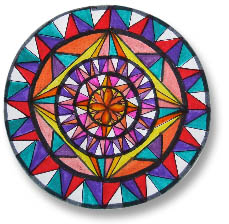 Workshop 5
Workshop 5
Journey to the Heart. Meditation and Mandala making
In this workshop discover your personal symbol and visual meditation in the form of a Mandala. The process of this session takes you through meditation techniques, visualizations, the creative process and image making to a place of renewal at the centre of your heart. In this session you will discover the nature and meaning of the elements - Earth, water, fire, air and ether and intergrate theses elements into your Meditation and Mandala.
 Mandala means ‘circle” in the Sanskrit language, and mandala art refers to symbols that are drawn sketched or painted in a circular frame. Mandala art has been used throughout the world as self-expression, in the service of personal growth and spiritual transformation. Tibetan Buddhism has employed mandala art for thousands of years to capture images of the countless demons and gods, which it believes both plagues and uplift humanity. Navaho sand painters use them in their healing rites. Many native people use the Medicine Wheel, a mandala to connect to earth energies and the wisdom of nature.
Mandala means ‘circle” in the Sanskrit language, and mandala art refers to symbols that are drawn sketched or painted in a circular frame. Mandala art has been used throughout the world as self-expression, in the service of personal growth and spiritual transformation. Tibetan Buddhism has employed mandala art for thousands of years to capture images of the countless demons and gods, which it believes both plagues and uplift humanity. Navaho sand painters use them in their healing rites. Many native people use the Medicine Wheel, a mandala to connect to earth energies and the wisdom of nature.
The very fact that mandalas are drawn round can lead us to an experience of wholeness when we take time to make them and then wonder what they mean. In the strict use of the Mandala, there is a central point within the symbol, from which radiates a symmetrical design. This suggests there is a centre within each one of us to which everything is related, by which everything is ordered, and which is itself a source of energy and power. Virtually every spiritual and religious system known to man asserts the reality of such an inner center. The Romans worshipped it as the genius within. The Greeks called it the inner daemon. Christian religions speak about the soul and the Christ within. In psychology we speak of the higher self.
Carl Gustav Jung claimed that the Mandala, or circular art form, had a calming and centering effect upon its maker or viewer.
And they allowed Apollonius to ask questions; And he asked them of what they thought the cosmos was composed; But they replied: “of elements.” “Are there then four “he asked” “Not four,” said Iarchas, “but five.” “And how can there be a fifth,” said Apollonius, “alongside of water and air and earth and fire?” “There is the ether”, replied the other, “which we must regard as the stuff of which gods are made; For just as all mortal creatures inhale the Air, So do the immortal and divine natures inhale the ether.” Apollonius again asked which was the first of the elements, And Iarchas answered: “All are simultaneous, for a living creature is not born bit by bit.” “Am I,” said Apollonis, “ To regard the universe as a living creature?’ “Yes,” said the other, “if you have a sound knowledge of it, for it engenders all living things.” -The Life of Apollonius of Tyana, Philostratus, 220AD